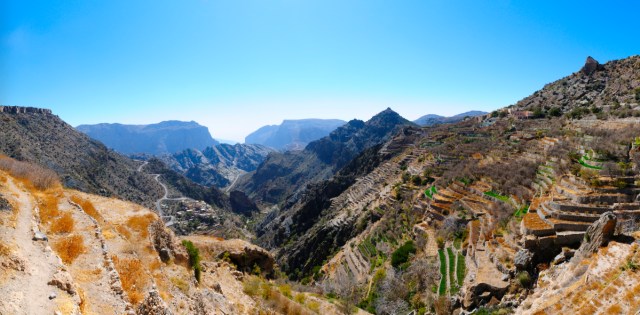The Al Hajar Mountains in Oman stand as one of the tallest ranges in the Arabian Peninsula. The photograph acknowledgment is attributed to Philipp Weigell from Wikimedia Commons.
As I prepare for my upcoming trip to India, marking a return after six and a half years, my usual inclination towards detailed, research-driven articles will take a backseat. Instead of immersing myself in dissecting current events, I have opted for a different approach, focusing on an unconventional subject – rocks. Departing from Zayed International Airport in Abu Dhabi, United Arab Emirates, the absence of clouds revealed a vast landscape unfolding some 30,000 feet below, showcasing an intricately textured terrain akin to an oil painting. Transitioning towards the northeastern region of Oman, we observed the Al Hajar mountain range from an aerial viewpoint.
The red-gray landscape, from my perspective, seemed intricately crafted and contoured as if by the skilled hands of an artist. Jebel Akhdar, among Oman’s highest peaks, towered over the desert expanse, with mining communities, tourist destinations, and vehicles scattered like contemporary artifacts amidst the timeless scenery. The mountains emanated a sense of enduring permanence that I had never before directly experienced, almost as if I were peering into the exposed core of the Earth, beckoning me to delve deeper into its essence (now I understand the perspective of geologists).
Approaching the coast, the roads connecting Oman’s natural marvels to the cities of Muscat and Salalah gradually faded, giving rise to winding remnants of a river etched on the land like strokes of wet paint. The retreating Arabian Sea tide left delicate traces of sediment and moisture trailing from the valleys, prompting reflections on how the landscape evolves with the ebb and flow of the sea. Furthermore, the riverbed and surrounding settlements nestled within a broader depression in the terrain evoked images of a distant era when a vast river or sea might have once occupied the region.
Further exploration unveiled that this speculation was not far from reality, though the geological processes lack the allure of speculation. The creation of the Al Hajar mountains and the scientific insights they provide are outcomes of millions of years of gradual, indifferent glacial and tectonic activities. Surprisingly, the scorching Omani terrain might have been cloaked in ice ages ago, lending credibility to the concept that this planet bore stark differences 700 million years in the past. Moreover, Oman’s mountains predominantly unveil the Earth’s crust – quite literally its flesh – while the meandering valleys, termed wadis, comprise pillow basalt, an igneous rock formed from underwater volcanic eruptions. Essentially, Oman’s scenic wadis are remnants of the ancient seabed that one can traverse today.
Despite my initial plan to curtail research due to an overseas wedding commitment, I found myself unable to resist delving into the wealth of academic studies and travel chronicles chronicling Oman’s geological past. The brief aerial encounter with the landscape from the airplane unveiled a rich tapestry of historical narratives that left me spellbound. The vast expanse of geological time underscores the awe-inspiring essence of physical geography. Human existence, in contrast, appears transient against the backdrop of these enduring formations. While some may interpret this insignificance as disheartening, I perceive it as humbling. Our fleeting presence on this planet underscores the value of each passing day. As a global community with a shared interest in conserving our Earth, we have a unique opportunity to extend our influence far beyond our individual lifetimes.
We find ourselves at a pivotal moment in history, where the adverse social and environmental consequences of the prevailing economic system, capitalism, are glaringly apparent. In India, where I currently reside, the alarming levels of air pollution in 2019 alone were linked to numerous fatalities, disproportionately impacting impoverished households with multiple dependents and inadequate sanitation facilities, along with individuals with disabilities. The primary culprits behind this environmental crisis are industrial and vehicular emissions, deemed vital for sustaining economic operations and financial transactions.
Even after my arrival in Bangalore and the subsequent recuperation from jet lag, my thoughts gravitate back to Jebel Akhdar. The exposed mantle of the mountains hosts a pioneering initiative by geologists to sequester atmospheric carbon dioxide through mineralization within the rock formations. Consequently, the Al Hajar range harbors significant potential to advance our technological efforts in combating climate change. However, we must proceed with caution, mindful of the risks associated with exploiting nature for human gain under the guise of environmental friendliness, potentially transforming carbon capture into another profit-oriented industry without addressing the underlying social disparities exacerbating climate change. Our time on this planet is fleeting, urging us to shoulder the responsibility of safeguarding the Earth from those who prioritize exploitation over conservation, ensuring a legacy for future generations.
Undoubtedly, it has been an enlightening journey.
